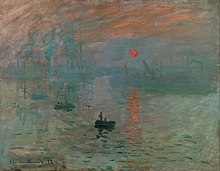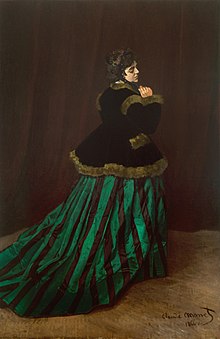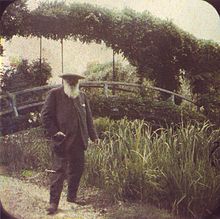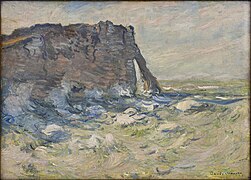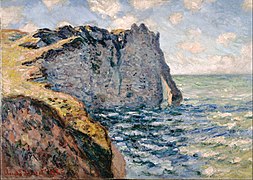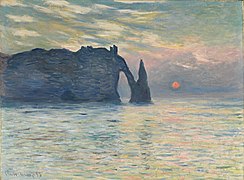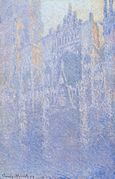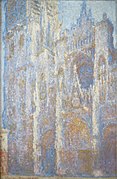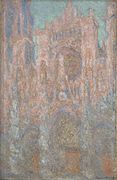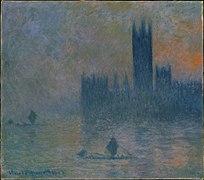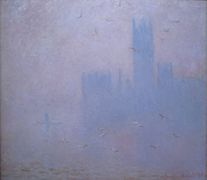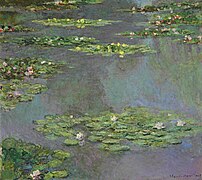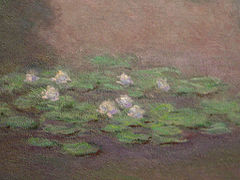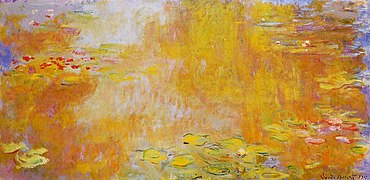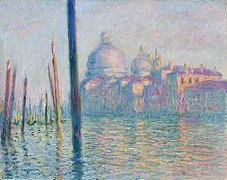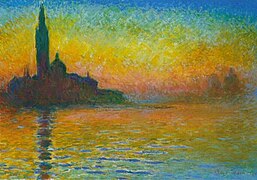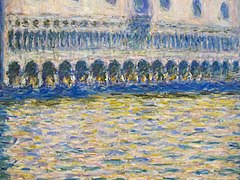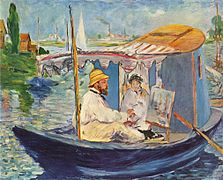Claude Monet
Claude Monet (Paris, November 14, 1840-Giverny, December 5, 1926) was a French painter, one of the creators of Impressionism. The term impressionism derives from the title of his work Impression, Rising Sun (1872).
His early works, up to the mid-1860s, are realistic in style. Monet managed to exhibit some at the Paris Salon. Beginning in the late 1860s he began to paint impressionist works. This deviation from the taste of the time, which was marked by art academies, worsened his economic situation while it strengthened his decision to continue on this hazardous path.
In the 1870s it was part of the Impressionist exhibitions in which Pierre-Auguste Renoir and Edgar Degas also participated. His work Print, Rising Sun was part of the Salon des Refusés in 1874. His career was promoted by the art dealer Paul Durand-Ruel, but despite this his financial situation remained difficult until the middle of the decade. from 1890. At this time, Monet developed the concept of "series", in which a motif is painted repeatedly with different lighting. At the same time he began work on the famous garden of his house in Giverny with water lily ponds which he later used as a motif for his paintings.
Life
Claude Monet was born on November 14, 1840 at 45 Rue Lafitte in Paris. He was the second son of Claude Adolphe Monet and his wife Louise Justine Aubrée, his father owned a business that traded spices from the French overseas colonies. On May 20, 1841, he was baptized in the parish of the local church, Notre-Dame-de-Lorette as Oscar-Claude. By 1845 the business situation had declined to such an extent that the family moved to the port of El Havre, at the mouth of the Seine, where his father's half-sister, Marie-Jeanne Lecadre, lived. Her husband, Jacques Lecadre, was a wholesale overseas spice merchant and ship supplier. He gave Monet's father a job in his business.Monet's family spent winters at their home in Le Havre and summers at the Lecadres' country house in the Sainte-Adresse spa. Later the family moved to Baraqueville but they did not stay there long because they had to move again for reasons of Adolphe Monet's work.
Between 1851 and 1857 Claude Monet attended secondary school in Le Havre, where he received drawing lessons from Jacques-François Ochard. He did not like school discipline and preferred to be on the cliff or by the sea.During his classes he drew caricatures of his teachers and other students that were exhibited in the window of Le Havre's only picture frame dealer. At the age of 15 Monet was already known as a caricaturist throughout the city and received commissions for which he charged up to 20 francs.
Training
Next to Monet's caricatures in the window of the marquería, seascapes by Eugène Boudin were on display. Monet did not like these paintings and he turned down an offer to meet Boudin. However, on one occasion, upon entering the shop, Monet did not realize that Boudin was present, and the merchant took the opportunity to introduce them. The painter praised Monet's talent and advised him not to limit himself to drawing and to paint landscapes outdoors.
After his mother's death on January 28, 1857, his aunt, who was an amateur painter and was in contact with the painter Armand Gautier, took care of the young Claude Monet. After the death of Jacques Lecadre, Claude's father took over the business and the family moved into the house that belonged to the deceased. Monet's first landscapes come from these years and he makes the decision to become a painter. Claude's father applied to the Le Havre magistrates for a scholarship, which was rejected on the first attempt. Despite this, Monet traveled to Paris to visit the Paris Salon exhibition. There he made contact with the artists Constant Troyon and Armand Gautier, and worked in the atelier of the painter Charles Monginot, who was a friend of Boudin's. During this time Monet obtained financial support from his father. He also had at his disposal 2000 francs that he had earned from his caricatures and which were managed by his aunt. From the year 1860 the financial support of his father was reduced, as Monet was opposed to enrolling in the École des Beaux-Arts, which his father wanted him to attend. Monet enrolled instead in the private painting school Academia Suiza, where he devoted himself to the study of figures. Monet visited exhibitions at the Barbizon artists' colony. The painters of the Barbizon School rejected the style, widespread at the time, of idealized landscapes and preferred instead landscapes with a new style of pictorial realism, where the impressions of light were more important. Monet also spent time at the Brasserie des Martyrs, a meeting point for various modern painters and writers.
In April 1861, Claude Monet was called up for compulsory military service, which lasted seven years. He was presented with the opportunity to avoid military service by paying 2,500 francs, but he lacked the necessary funds and his family only offered to make the payment if he would abandon painting and take over the business in Le Havre. Monet decided on painting and was posted to the cavalry in Algeria. Because he fell ill with typhoid fever, he was able to return to Le Havre in the summer of 1862. There he met the Dutchman Johan Barthold Jongkind, with whom he studied outdoor landscapes. In November 1862 he was released from the last six years of military service by a payment of 3,000 francs made by his aunt. His pictorial education was entrusted to Auguste Toulmouche, a Parisian genre painter, who was married to the cousin of his aunt Marie-Jeanne Lecadre. He recommended Monet to go to Charles Gleyre's atelier, where Pierre-Auguste Renoir, Alfred Sisley and Frédéric Bazille were also registered. During Easter 1863 Monet traveled with Bazille to Chailly, near Barbizon, where they painted landscapes. They repeated the trip the following year. He continued his studies at Gleyre's atelier until it closed in July 1864 due to the master's illness. That summer Monet and Bazille traveled to the Normandy Channel coast, followed later by Boudin and Jongkind, to paint. Due to disagreements, Monet's family threatened to end their financial support, so he first borrowed money from Bazille. During his studies, despite his economic difficulties, Monet presented himself as bourgeois and wore fine shirts, for which he was taken as a dandy by his classmates.
Exhibitions at the Paris Salon
In 1864 a still life of flowers by Monet was exhibited at an exhibition in the city of Rouen. At the same time he received a commission from Louis-Joseph-François Gaudibert to paint two portraits. This commission had an important meaning for Monet because Gaudibert's son later commissioned other portraits that helped him financially. In late 1864 or early 1865, Monet and Bazille established a joint atelier in Paris. At the Paris Salon in 1865, Monet was able to show two seascapes. These paintings were well received by critics and led to Monet planning the monumental work Breakfast for the Salon exhibition of 1866. However, he was unable to finish the painting in time. During the work on this work, he used Camille Doncieux as a model, with whom he established a loving relationship. Monet planned the painting in imitation of Édouard Manet's Lunch on the Grass, which had caused a scandal by presenting a nude woman without a mythological background, but Monet's painting was rather conservative and it suited the taste of the masses. Monet was an admirer of Manet's work and from 1866 on he was in close contact with him. As the painting planned for the Salon could not be finished on time, Monet painted the work Camille in a Green Dress in just four days, which was received positively by critics.
Due to his financial difficulties, he faked a break with Camille to get closer to his family, from whom he expected financial help. For this reason he spent the summer of 1867 with his family in Sainte-Adresse, while Camille, who was pregnant, remained in Paris and was cared for by Bazille. On August 8, 1867, Monet's first child, Jean, was born. Because he did not want to leave his mistress and his son helpless, he returned to Paris.That year the painting Women in the Garden was rejected by the Salon. To financially support his friend, Bazille bought this work in installments and took it back into his atelier . Monet's financial situation continued to be difficult and in 1868 he lived at Étretat and Fécamp, where he again obtained commissions from the shipping company Gaudibert, who also paid for the completion of some of Monet's paintings. At the end of the year he fled again from his creditors to Paris. In 1870 the jury again rejected a painting prepared for the Salon. On June 26 of that year he married Camille Doncieux. By his selection of subjects and style of painting, Monet distanced himself more and more from the Paris Salon and therefore from economic success.
With the outbreak of the Franco-Prussian War in July 1870, Monet left France and moved to London to avoid being drafted. His friends Bazille and Manet participated in the war. On November 28, 1870, Bazille died on the front lines of battle. During his stay in London, Monet became acquainted with the art dealer Paul Durand-Ruel, as well as the works of landscape artist William Turner, in whose paintings contours are blurred by light. On July 17, 1871, Claude's father died and he received a small inheritance. At the end of the war, in the autumn of 1871, Monet returned to France traveling through the Netherlands. He rents a house with a garden in Argenteuil and thanks to Camille's inheritance and dowry, the family enjoys bourgeois well-being for the first time. In 1872 Durand-Ruel sells several paintings by Monet, who sets up a boat and paints on the banks of the Seine.
Impressionist exhibitions
In 1873 Claude Monet met Gustave Caillebotte in Argenteuil, with whom he agreed to hold joint exhibitions. For this purpose, the Sociéte Anonyme Coopérative d' Artistes-Peintres, -Sculpteurs, -Graveurs, etc. This society was joined by the artists who would later form the nucleus of Impressionism.
The group's first exhibition was held in 1874 at the photographer Nadar's atelier on Boulevard des Capucines in Paris. Inspired by one of the works on display, Impression, Rising Sun, which Monet had painted in 1872 in Le Havre along with other works, the art critic Leroy, from the magazine Le Charivari, called it "the exhibition of the impressionists." This is how the term impressionism was born, which was initially used as a joke by critics and was later used by the same artists, based on Monet's painting. The exhibition did not have much resonance and the society was dissolved at the end of that same year. In 1876 a second Impressionist exhibition was held at the premises of the art dealer Durand-Ruel where Monet exhibited 18 paintings. In that year he met Ernest Hoschedé, who owned a department store and who commissioned him to paint some decorative panels for the Rottenbourg castle. On March 17, 1878, Monet's second son, Michel, was born. That summer the family moved to Vétheuil, where Alice Hoschedé followed with her six children, after her husband declared bankruptcy. On September 5, 1879, Monet's wife, Camille, died at the age of 32, as a result of a botched induced abortion.
In 1881 Durand-Ruel bought more of Monet's paintings and also supported him financially so that he took a trip to the Normandy coast to paint. In December 1881 Claude Monet and Alice Hoschedé moved with their children to Poissy.
The Impressionists exhibition of 1882 is the last in which Monet participates. From that moment on, his distance from the other impressionists is increasingly marked and they accuse him of not supporting the group for selfish reasons. Monet tried again to exhibit at the Paris Salon and one of his paintings was accepted by the jury.
Giverny
In 1883, Durand-Ruel organizes a solo exhibition with paintings by Monet. This exhibition was met with favorable reviews, however it did not result in great sales. Despite this, Monet's financial situation improved thanks to the revival of the market for Impressionist works from the beginning of the 1880s. Monet rented a house in Giverny where he created his famous garden. He moved there with his two children and Alice Hoschedé and theirs.
In December 1883, he went with Renoir to the Mediterranean coast. Both travel the route from Marseille to Genoa and then visit Cezanne at L'Estaque. After a brief return to Giverny, Monet only resumed his journey south in January 1884. He went this time to Bordighera and Menton. Impressed by nature and wild landscapes, Monet paints about forty paintings representing the most picturesque places such as the Sasso or Nervia valleys.
In November 1884, he began a long friendship with the writer Octave Mirbeau, who from then on became his official bard and contributed to his recognition.
In 1885, on the occasion of a trip to the Normandy coast, in Étretat, Monet entered into an agreement with the gallery owner Georges Petit, so that he could buy and sell some of the painter's works. As a result, the exclusivity that Durand-Ruel had until then was broken. At the end of the year, Monet announced his desire to deal solely with Petit. On the other hand, Monet, not wanting to be totally dependent on gallery owners, interviews and develops his network of collectors.
In 1886, despite the rift between the two men, Paul Durand-Ruel opened the doors of the American market for Monet by establishing links with the American Art Association. The official recognition he obtains on the other side of the Atlantic helps develop the market for Impressionist art in France in the 1890s.
In 1886 he made another trip to the Netherlands. In the autumn of 1886 Monet paints in Brittany, where he meets his future biographer, Gustave Geffroy. From January to April 1888 he paints on the Côte d'Azur and in the summer he travels again to London. After his return to France, he refused the cross of the Legion of Honor. The following year he raised money to buy the painting Olympia from the widow of his friend Manet, which he would later donate to the Louvre. In 1890 Monet bought the house in Giverny, in which he had lived for several years, thanks to the fact that his financial situation had improved due to the regular sales of his works. With additional land purchases he expanded his property more and more and invested a lot of money in caring for his garden. He faced the mistrust of the local peasants who feared some danger to his land and livestock, since Monet planted exotic plants such as the tuberose from Mexico among other exotic species. In the late 1880s a small group of American painters visited Giverny to meet Monet. Among them was Theodore Robinson, who was one of the first American artists to introduce impressionism into his work. Monet did not maintain close contact with the so-called "Givernists" since he never wanted to assume the role of teacher.
In 1891 Ernest Hoschedé died, which allowed Monet and his widow, Alice, to legitimize their relationship through marriage in July 1892. In that same year, his stepdaughter Suzanne married one of the "Givernists", Theodore Butler painter. In 1895 Monet traveled to Norway, where he visited one of his stepsons.
In 1897 he built a second atelier in Giverny as he needed more space for his work. At the same time, twenty of his paintings were exhibited at the Venice Biennale. During the summer his son Jean married his stepsister, Blanche Hoschedé. The years 1896 and 1897 are going to be much calmer for Monet. In fact, he devoted himself more to his Giverny gardens: on the one hand, continuing to develop them and, on the other hand, beginning to use them as a motif for his paintings (which lasted until the end of his life).. Furthermore, he did not travel much, except to go to the Normandy coast, especially to Pourville and Varengeville where he painted La Maison du pêcheur or La Falaise in Varengeville .
In the Dreyfus Affair, Monet strongly supported Zola in 1897 and expressed his admiration for the defendant. In particular, he signed the so-called petition & # 34; manifesto of intellectuals & # 34; published in the newspaper L'Aurore, but refused to participate in a support group.
In 1898, he learned of the death of his boyhood friend, Eugène Boudin
In January 1899, shortly before he died, Alfred Sisley summoned him to his home in Moret-sur-Loing and entrusted his children to him. On May 1, 1899, Claude Monet organized a sale by the Galerie Georges Petit for the benefit of Sisley's children, which was a great success due to the price his works achieved and received an echo in the media unprecedented for Sisley.. In 1899 and 1900 Monet made several trips to London. Along with his wife Alice, he traveled by car to Madrid where he studied the Spanish masters. At Giverny he worked mostly on paintings of water lilies, in 1906 he several times postponed an exhibition planned by Durand-Ruel.
Last years and death
In 1908 the first signs of Monet's eye disease were evident. Between September and December of that year he and his wife were in Venice, where he not only painted, but also studied the works of the artists Titian and Paolo Veronese in the city's churches and museums. On May 19, 1911, his second wife, Alice, died. The following year his vision worsened and he was diagnosed with cataracts in both eyes. In 1912 his paintings in Venice were exhibited at the Bernheim-Jeune gallery with great success. Georges Clemenceau and other friends recommended in 1914 that he donate paintings from the water lily series to the French state, but Monet, who had on other occasions refused honorary state titles, was not persuaded. After the death of his son, Jean Monet, his widow took over the household affairs in Giverny. In 1915 Monet had a third atelier built there, even larger than the previous ones, where he painted the water lilies (nymphea) in his garden.
At the end of World War I with the armistice of November 11, 1918, Monet donated eight of his paintings from the water lily series to the French state. In 1921, depressed by his increasing blindness, he considered requesting the return of the paintings. In that same year, a large retrospective exhibition of his work was held at the Durand-Ruel premises. It was not until 1922, at the request of his friend Clemenceau, that Claude Monet signed a notarial agreement that legalized the donation, with which the paintings became property of the State. After two cataract operations in 1923, Monet regained his sight. He began to paint his large water lily paintings again, but was hampered by depression.
In his later years Monet destroyed several of his paintings at his own expense, as he did not want unfinished works, sketches, and drafts to enter the art market, as they did after his death. On December 5, 1926, he died at Giverny.
His house was donated by his son Michel, his only heir, to the French Academy of Fine Arts in 1966. Through the Claude Monet Foundation, the house and gardens were opened to the public in 1980 after restoration and it is currently an attraction for tourists from all over the world who visit Giverny.
Work
No painter in the group was as purely Impressionist as Monet. In his work the dominant factor is a clear effort to incorporate the new way of vision, especially the character of light, while the composition of large masses and surfaces serves only to establish a certain coherence. For his part, Renoir was the painter who convinced us that the aesthetics of impressionism was, above all, hedonistic. Pleasure seems the most evident quality of his work, the immediate and burning pleasure that painting produces in him. He was never overwhelmed by problems of style and went so far as to say that the object of a painting is simply to decorate a wall and that is why it was important that the colors be pleasing in themselves.
Of all the Impressionists, Monet was the one who most emphatically practiced pleinairism, that is, the practice of painting plein-air (French: 'full, total air' 39; and also —and that is the meaning that matters most to us here— open air), painting in the open air. Although there is a large number of landscape painters prior to Monet, it is noticeable in them that the invoice for his works has been carried out mainly within the workshop after a previous sketch. Until the second half of s. XIX, the paintings (oil, tempera) were made by hand and packaged in bottles, knobs, etc. The invention of paint jars and tubes (a positive product of the Industrial Revolution), allowed painters to take their oils or temperas outdoors, under the sun, without these elements drying or oxidizing quickly as had happened until then..
In the open air, under direct sunlight, he was able to meticulously observe and capture almost immediately, with free brushstrokes, the effects of light on objects, the changes, the vibrations of that light; for this reason Monet's painting is especially vital and full of harmonies.
Inspired by the environment of his gardens in Giverny, in 1906 he began the series of very large paintings on aquatic floral plants, (the paintings of water lilies and water lilies that can currently be admired in the Parisian museum of La Orangerie).
Everything can be deduced from a simple statement made by the artist:
The motive is for me at all secondary; what I want to represent is what exists between motive and me. Claude Monet
Although some authors continue to attribute his pictorial abstraction to his vision problem, considering his return to a more controlled style after cataract operations in 1923.
Series
Etretat
Monet felt during many of the years of his career before Giverny very attracted by the Norman coast and especially by the cliffs of Étretat with its famous arch the Porte d'Aval, which he painted from different perspectives and in various weather and lighting conditions.
- Etretat Cliffs
The Haystacks (1890-1891)
The year 1890 was a pivotal year in Monet's life. Work trips become much rarer. The time of the series arrived, a pictorial genre known by his friend Boudin, whose idea was gradually imposed with the stations of Saint-Lazare, then for example in 1886 with the two versions of the figure in the open air of the Woman with umbrella turned to the right and the Woman with an umbrella turned to the left), the Rocks of Belle-Île the same year and especially La Petite Creuse in 1889, during his stay in Fresselines. This period began in the late 1890s with Los Almiares, a series of more than twenty versions. These mighty haystacks of wheat were close to his house. He began to paint them in 1888, but the year 1890 really marks the beginning of the tireless repetition of the same motif in search of different effects. This rooting is confirmed by the purchase of the Clos de Giverny in the autumn of 1890 for 22,000 francs.
Only two months later, on May 4, 1891, an exhibition dedicated to Monet opens its doors at the Durand-Ruel gallery in Paris. With the title of recent works by Claude Monet, it proposes, among other things, fifteen paintings of The Haystacks. In the catalogue, each of these canvases bears the title Hacks, but with the indication of the moment collected. Both the paintings and this presentation detail are a critical hit, especially with journalists.
- Almiares series
Los Alamos
In 1891, Monet followed the course of the Epte in search of a new motif that could be the subject of a series: Los Alamos. He works there from late spring to late fall. On October 8, 1891, he paid the lumber merchant to delay the felling of these trees in Limetz.
Immediately completed, this series aroused the interest of dealers and gallery owners: Maurice Jouant, bought several canvases for the Boussod et Valadon gallery; Durand-Ruel purchased seven of them for 28,000 francs and created an exhibition dedicated exclusively to this series.
- The Alamos Series
Rouen Cathedral (1892-1895)
In 1892, Monet searched for a new subject that could be the subject of a series and that was not a natural element. The choice of him is based on the cathedral of Rouen. His first works, which he carried out from Fernand Levy's house, located in front of the cathedral, did not turn out as he wanted. When he returns to Giverny in April, dissatisfied, he refuses to show the results to anyone except his closest friends. He returned to Rouen on February 16, 1893, and moved to two different places, always in front of the building and at different times of the day.
He completed the twenty-eight paintings that made up the series of cathedrals in the studio in 1894. Like the previous series, cathedrals are doomed to success and Monet knows it. That is why he is going to make his gallery owners compete, especially between Georges Durand-Ruel and Georges Petit. This stratagem allows him to obtain the best exhibition conditions and a larger sum of money for the sale of these paintings.
For the cathedral series, Durand-Ruel obtained the exclusivity of exhibiting it (at a not insignificant price of 12,000 francs for each of the canvases). This exhibition takes place from May 10 to May 31, 1895, and is entitled "Recent Works". Success occurs again. Among the many criticisms by journalists, that of Georges Clemenceau, entitled Revolution of the Cathedrals, stands out particularly for the relevance and accuracy of its analysis.
Finally, it should be noted that at the beginning of 1895, that is, before the exhibition dedicated in part to the cathedrals, Monet traveled to Norway, to Christianía, present-day Oslo. He places his trestle in particular on Lake Daeli, Mount Kolsaas, Kirkerud or Sandviken. He painted a total of 28 paintings that he only touched up once he returned to France.
- Ruan Cathedral Series
Views of London (1899-1904)
In the autumn of 1899, with his wife, he made the first of a series of three trips to London to visit his son Michel, who had lived there since the spring. During these three stays from 1899 to 1901, he painted a series dedicated to the Parliament of London and whose recurring theme is the fog over the Thames. Production of this series continues with retouching work in the studio until 1904. The series Views of the Thames in London 1900 to 1904 is exhibited in May and June 1904 and is the greatest triumph of the career of the painter until then.
In 1900, the Impressionists were exhibited at the World's Fair in Paris, a sign of official recognition. His canvases, two of them by Monet, are on display at the Grand Palais as part of the Centenary exhibition.
In 1904, from May 9 to June 4, Monet exhibited at the Durand-Ruel gallery. He presents thirty-seven views of the Thames in London. Despite obtaining an undeniable success, the critical voices, more receptive to the geometric forms imposed by Cézanne, manifest themselves, rejecting the dissolution of the forms that Monet shows in his canvases.
- London View Series
The Water Lilies
After London, Monet painted mainly controlled nature: his own garden, his water lilies, his pond and his bridge. From November 22 to December 15, 1900, a new exhibition dedicated to these themes was held at the Durand-Ruel Gallery. A dozen versions of Les Nymphéas are presented. The same exhibition was organized in New York in February 1901, where it was a great success.
In 1901, Monet enlarged his pond by buying a meadow on the other side of the Ru, the local river. He then divides his time between working in nature and working in his studio.
The paintings dedicated to water lilies evolve according to the transformations of the garden. In addition, Monet gradually changed the aesthetic, abandoning, around 1905, any landmark of the limit to the level of the water and therefore of perspective. He also changed the shape and size of his canvases from rectangular supports to square and then circular supports.
It is important to note, however, that these paintings are created with great difficulty: Monet, in fact, spends time reworking them to find the perfect effect and impression, and when he fails, he does not hesitate to destroy them. After several postponements since 1906, the exhibition, called Les Nymphéas, series of water landscapes, finally opened on May 6, 1909. Comprising forty-eight canvases from 1903 to 1908, this exhibition is again a great success.
- The Nenúfares series
Venice
In the fall of 1908, Monet and his wife stayed in Venice, in the Palazzo Barbaro, in the company of an elite passionate about art. In this good company, the painter is often distracted and has some difficulty in his work. During the month of his stay, he makes only a few sketches. As a result, he paid a second visit a year later, and this time he produced many paintings that he would return to take in his studio. They were finally delivered in 1912 and exhibited in the gallery of the Bernheim-Jeune brothers.
- Venice Series
Importance
Artistic significance and notoriety
Monet's work reflects the influence of various stylistic trends. His early works belong to pictorial realism, from which he moved further and further away throughout his career. He was a leading member of the Impressionists, and some of his works are among the most important in this style of painting. His late works are composed mainly of series of landscapes and gardens. The paintings in the series of water lilies that Monet donated to the French state, were presented to the public on May 17, 1929 at the Musée de la Orangerie as Musée Monet, but the exhibition aroused little interest. In these rooms a retrospective of Monet was shown in which works from the late period were underrepresented. Subsequently, the museum organized other exhibitions in these same rooms, which contravened the agreement made with the artist. For the presentation of Flemish tapestries from 1935, Monet's paintings were even taken down to put the tapestries in their place. Critics rated the late work negatively due to its loose shapes and intense colours, considering that it lacked empirical contact with nature, thus contradicting the idea that Impressionism gave an exact optical representation of nature. Until the 1980s, with few exceptions, art history differentiated between early Impressionist works, which includes paintings created between 1870 and 1880, and less valued late works. Between 1880 and the end of the century, Monet was seen by critics as a visionary. After 1890 his paintings fall between naturalism and abstractionism, which makes it difficult to classify the stylistic tendency of his later works.
Artists such as Max Liebermann, Giovanni Giacometti, and Lovis Corinth valued and were influenced by Monet's Impressionist works. This influence of Monet, even after his death, petered out with the death of Pierre Bonnard in 1947, who called himself the "last impressionist." Although the Cubists rejected Monet's work, especially for the dissolution of forms, many foreign painters, such as Wassily Kandinski, recognized Monet's importance for modernity.
In the late 1940s and 1950s there was a revival of interest in Monet. In 1947 Marc Chagall said: “Monet is for me the Michelangelo of our time.” However, in his opinion, late works did not have a special position. André Masson expressed a different opinion in 1952, when he called the large oil paintings of water lilies "the Sistine Chapel of Impressionism."
Much of Monet's growing popularity was due to postwar painting in the United States, in which the gesture returned to the forefront, and in which anti-rationalism prevailed. Interest in Monet's late works resurfaced with the advent of abstract painting. More than three hundred American artists traveled to Paris in the 1950s, where, among others, they studied Monet. These events were the impetus for the first major solo exhibitions in the 1950s, which led to international recognition of Monet's work. Among these, the impressionist exhibition at the Kunsthalle Basel in 1949 is of special importance. The revival in interest in Monet's work also led to an increase in the number of visitors to the Orangerie.
Commercial success
For much of his artistic career, Monet lived in poverty. His works, like the works of other artists who did not adhere to the classical style preferred by the public, were ignored by buyers at the time. With the economic boom after the Franco-Prussian War of 1871, prices rose, and even works by Impressionist artists fetched surprisingly high prices. Art dealer Paul Durand-Ruel, who met Monet during his stay in London, bought works by Monet and other critically rejected artists for many years. He didn't pay much, but that regular income allowed Monet to lead a financially secure life. From 1873 Durand-Ruel had to restrict his support for Impressionist artists due to a strong economic crisis in France, which affected the art market. The fall in prices was especially strong in Impressionist-type works. Thus, in 1874 Ernest Hoschedé was able to buy the painting Impression, Rising Sun for 800 francs, but at the subsequent auction forced by the bankruptcy, in 1877, the work reached a price of only 200 francs. This auction clearly documents the drop in prices for works by Impressionist artists. Monet's financial situation worsened again. At the end of 1878 Monet said of this: "I am not a beginner, and it is terrible at my age to be in this situation, having to beg and bother buyers." Monet's situation did not improve until he moved to Giverny, when Durand-Ruel was able to restart his support for the Impressionists. Monet's works gained recognition, and prices for his paintings rose. In the mid-1890s, paintings in the Rouen Cathedral series fetched a price of 15,000 francs. At his house in Giverny he was visited by important art collectors such as Matsukata Kojiro.
In the late 1980s, works by Impressionist artists reached auction prices that have not been beaten to date. Monet is the only exception. One of his 1907 water lily paintings fetched a price of $10.5 million in 1989, and the same painting was sold at Christie's auction for $2 million in November 2005. This it is because very few of Monet's works are available on the market. In 2004 there were 26, in 2005, 22 and in 2006, 28 paintings. In June 2007 a 1904 Water Lily Series painting, valued at £10-15 million, was auctioned at Sotheby's for £18.5 million. The buyer was an Asian collector. It became Monet's fourth most expensive painting, only surpassed by the painting of water lilies Le Bassin aux nympheas which in 2008 fetched 51.7 million euros at Christie's auction house; the painting Railroad Bridge at Argentuil, which sold in May 2008 for $41.4 million, also auctioned by Christie's; and a painting of water lilies from 1900 that was auctioned at Sotheby's in 1998 for £19.8 million.
Influence
Monet's works are frequently used on calendars and postcards, thus becoming part of our daily lives. In addition, Monet and his work were a source of inspiration for other impressionists.
Literature
French author Marcel Proust was inspired by Monet's work. Proust was akin to impressionism in general and particularly admired the works of Monet. Although he does not mention them specifically, there are thematic parallels in his writing with Monet's work.Proust describes in his novel In Search of Lost Time phenomena that Monet captures on canvas. The narrator gives his impressions of the clouds and the sea in the fictitious seaside resort of Balbec. In Jean Santeuil, a fragmentary novel, Proust himself mentions Claude Monet several times when a Rouen collector buys some of his paintings. The narrator describes with this reason the feelings that five paintings by the painter arouse in him.
Children's Literature
In 2020 Monet and Impressionism was published, an illustrated children's album by the authors Ángel de Frutos and Leticia Rodríguez that takes advantage of the painter's experiences to tell a story of improvement and enhancement of difference, combining education in values with artistic education.
Painting
Claude Monet was captured in several paintings done by his friends in the group of Impressionist artists. Pierre-Auguste Renoir portrayed him three times. The first painting, from 1872, shows him sitting smoking a pipe and reading the newspaper. In the second painting, from 1873, Monet is seen painting in his garden. In the third painting, from 1875, Monet is shown standing, with a brush and a palette in his hands. Édouard Manet also portrayed Monet in a painting that shows him with his wife Camille, on the boat- atelier that he used to paint on water.
Monet's influence can be seen in several modern artists. Jackson Pollock's thick color textures are reminiscent of Monet's late works. Pop artist Andy Warhol's "Flowers" series was inspired by Monet's series of water lily paintings, and can be seen at the Museum of Modern Art in New York.
Cinema
In the 1915 film by director Sacha Guitry, Ceux de chez nous, French cultural life during the First World War is assessed. The film focuses mostly on Renoir, but also Degas and Monet, who is seen painting one of his water lily paintings.
The sky in Monet's painting, The Bridge of Argenteuil (1874) is mentioned in the 2001 film Vanilla Sky. The protagonist lives in a created world for his imagination that differs from reality by having a vanilla-colored sky, as in Monet's work.
Prior to this, one of his works is used as a prop in the film The Thomas Crown Affair (1999), where an art-obsessed American millionaire steals a painting just for fun.
Comic and graphic novel
In 2017, a graphic novel was published that narrates the early years of the painter until his establishment in Giverny, the work of the scriptwriter Salva Rubio and the cartoonist Ricard Efa, entirely painted in gouache. In France, Belgium and the Netherlands it was published by Le Lombard, and in Spain, by Norma Editorial.
Honors
Eponymy
- Cultivate pink Claude Monet by Casa Delbard.
Contenido relacionado
Fritz lang
John schlesinger
Carl Sagan
